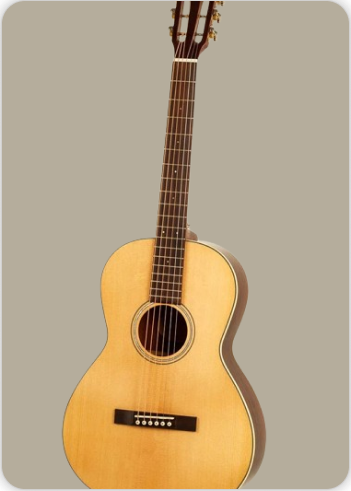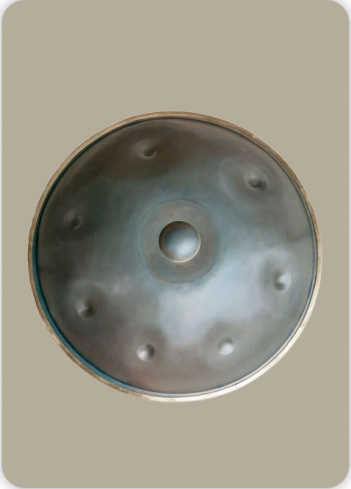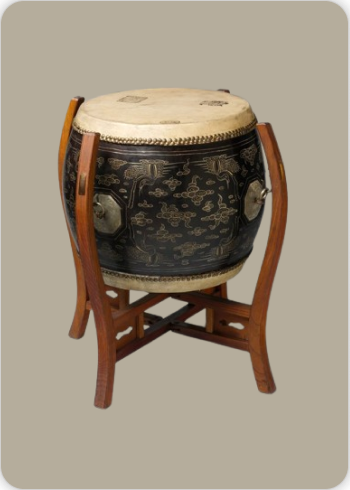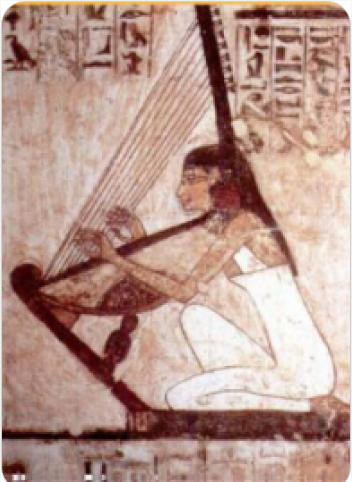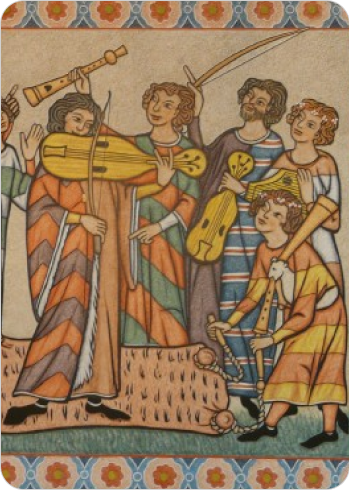Tati
Plucked Instruments
Asia
Between 1001 and 1900 AD
Video
The Tati is a traditional stringed musical instrument that holds a special place in the cultural heritage of the Naga people of Northeast India, particularly among the Angami, Chakhesang, and Mao Naga tribes. This instrument is characterized by its unique construction and evocative sound, which accompanies various forms of folk singing and storytelling. The Tati is a single-stringed, plucked instrument, typically measuring about three to four feet in length. Its body is ingeniously crafted from a dried, carved-out bottle gourd, which serves as a resonator. This gourd is covered with a thin membrane, originally made from animal bladder, and attached to one end of a long bamboo pole. A single string, usually made from plant fiber or modern synthetic material, is stretched between the two ends of the pole, passing over the membrane-covered gourd. The Tati produces a deep, resonant tone that complements the vocal traditions of the Naga people, providing both rhythm and melodic guidance for singers.
Type of Instrument
The Tati is classified as a plucked string instrument, belonging to the broader family of chordophones. Its closest relatives in the world of musical instruments are the ektara of India and other single-stringed folk instruments found across Asia. The Tati is played by plucking its single string, which vibrates over the resonating gourd to produce sound. Its design is simple yet effective, allowing for expressive musical accompaniment with minimal resources. The instrument is primarily used to accompany folk songs, known as Lu, Li, or Lo, which are central to the oral traditions of the Naga tribes. These songs encompass a wide range of themes, from celebrations and festivals to lullabies and laments, making the Tati an integral part of Naga cultural expression.
History of Tati
The origins of the Tati can be traced back to the Asian continent, specifically to the northeastern region of India and parts of northwestern Myanmar. The instrument has been in use among the Naga people since time immemorial, with its precise date of invention lost to history. However, it is widely acknowledged as an ancient instrument, deeply embedded in the traditional practices of the Naga tribes. The Tati’s enduring presence is a testament to the resilience and continuity of Naga culture, surviving through centuries of social and political change. Its use has been documented in various festivals, rituals, and communal gatherings, reflecting the instrument’s importance in both secular and sacred contexts. The Tati’s history is intertwined with the broader narrative of Naga identity, serving as a symbol of cultural continuity and artistic ingenuity.
Construction and Physical Structure
The construction of the Tati is a remarkable example of resourcefulness and craftsmanship. The main components of the instrument are:
The body of the Tati is made from a dried and hollowed-out bottle gourd. This gourd is carefully selected for its size and shape, then carved to create a resonating chamber. The open end of the gourd is covered with a thin membrane, traditionally made from the bladder of an animal. This membrane acts as a soundboard, amplifying the vibrations of the string. Attached to the gourd is a long pole, typically made from a special kind of bamboo known locally as Ruki or Dithuh. The pole extends from the gourd, providing the structural support needed to stretch the string.A single string is tied between the two ends of the pole, passing over the membrane-covered gourd. The string was originally made from natural fibers, such as plant material or animal gut, but modern versions may use synthetic strings for durability.
Some versions of the Tati may include a small bridge to elevate the string above the membrane and simple tuning pegs to adjust the string’s tension and pitch. The instrument’s design is minimalist yet effective, allowing for a wide range of tonal variation depending on the materials used and the skill of the maker. The Tati is lightweight and portable, making it ideal for use in communal gatherings and outdoor performances.
Types of Tati
While the basic structure of the Tati remains consistent, there are variations in design and construction among different Naga tribes and regions. These variations are often reflected in the names given to the instrument, such as Lubo, Libuh, or Lobvü. The differences may include:
Size and Shape of the Gourd: Some Tatis feature larger or smaller gourds, affecting the instrument’s tonal quality and volume.
Type of Membrane: The choice of membrane material, whether animal bladder, synthetic film, or other substitutes, can influence the resonance and timbre of the instrument.
Length and Thickness of the Pole: The dimensions of the bamboo pole may vary, impacting the tension and pitch range of the string.
String Material: Traditional strings made from plant fiber or animal gut are sometimes replaced with modern materials, resulting in subtle changes to the instrument’s sound.
Despite these variations, the fundamental playing technique and musical role of the Tati remain consistent across different communities. The instrument is always played by plucking the string, either solo or in accompaniment with group singing, and serves as a rhythmic and melodic guide for folk performances.
Characteristics of the Tati
The Tati possesses several distinctive characteristics that set it apart from other traditional instruments:
The Tati’s straightforward design makes it accessible to a wide range of people, from skilled musicians to amateur performers. Its construction relies on locally available materials, ensuring that the instrument can be made and maintained within the community. Despite having only one string, the Tati is capable of producing a rich and resonant tone. The combination of the gourd resonator and the membrane soundboard amplifies the string’s vibrations, creating a sound that is both deep and clear. The Tati is more than just a musical instrument; it is a vessel for cultural expression and storytelling. It accompanies traditional songs that convey the history, values, and experiences of the Naga people, making it an essential part of communal life. The Tati can be played solo or in ensemble settings, often accompanying group singing during festivals, rituals, and social gatherings. Its rhythmic and melodic capabilities make it suitable for a wide range of musical genres within the folk tradition. For the Naga tribes, the Tati is a symbol of cultural identity and pride. Its continued use in contemporary performances and festivals reflects the community’s commitment to preserving its heritage.
Role in Naga Culture and Music
The Tati occupies a central role in the musical and cultural traditions of the Naga people. It is most commonly associated with the performance of folk songs known as Lu, Li, or Lo, which are integral to the oral transmission of history, customs, and values. These songs are performed on a variety of occasions, including:
Celebrations and Festivals: The Tati is a staple at communal celebrations, such as harvest festivals, weddings, and other significant life events. Its music sets the tone for joyous gatherings and communal dances.
Rituals and Ceremonies: In addition to secular events, the Tati is used in rituals and religious ceremonies, where its music is believed to invoke blessings and connect the community with ancestral spirits.
Storytelling and Education: The instrument serves as an accompaniment for storytelling, helping to convey moral lessons, historical narratives, and cultural knowledge to younger generations.
Mourning and Lament: The Tati’s plaintive sound is also employed in songs of mourning, providing comfort and expression during times of loss.
The Tati’s versatility and emotional range make it an indispensable part of Naga musical life, bridging the gap between past and present.
Contemporary Revival and Preservation
In recent years, there has been a renewed interest in the Tati, driven by efforts to revive and preserve traditional Naga music. Folk fusion artists and cultural organizations have played a significant role in bringing the instrument to new audiences, both within India and internationally. Groups such as the Tetseo Sisters have incorporated the Tati into their performances, blending traditional melodies with contemporary arrangements to create a unique musical fusion. These efforts have helped to ensure that the Tati remains relevant in the modern era, inspiring a new generation of musicians and listeners. The instrument is also featured prominently in cultural festivals, such as the Hornbill Festival in Nagaland, which celebrates the rich heritage of the region’s diverse tribes. Through workshops, performances, and educational initiatives, the Tati is being introduced to young people and visitors, fostering a deeper appreciation for its historical and artistic significance.
Playing Techniques and Sound Modifications
The Tati is a single-stringed traditional musical instrument of the Naga people, measuring about 3 to 4 feet in length. It is constructed from a dried, carved-out bottle gourd covered with a thin membrane, originally the bladder of an animal, stretched over one end and attached to a pole. A single string is tied between the two ends of the pole, passing over the membrane, which acts as a resonator. The player plucks this string to produce sound, often accompanying traditional folk songs known as Lu, Li, or Lo depending on the dialect and tribe. Playing the Tati involves plucking the single string with fingers, producing a resonant, droning sound that supports the vocal melody. The tension of the string and the pressure on the membrane can be subtly adjusted by the player to modify pitch and timbre, allowing expressive nuances in the music. The instrument’s design and playing technique emphasize simplicity and intimacy, with the sound often described as warm and earthy, well suited to the storytelling and emotional expression of Naga folk music.
Though the Tati has a straightforward construction, skilled players can vary the sound by changing the plucking position and force, as well as by manipulating the membrane’s tension, creating a range of tonal colors and dynamics. This flexibility allows the instrument to be both a rhythmic and melodic companion in traditional performances.
Famous Compositions
The Tati is primarily used to accompany traditional Naga folk songs, which are passed down orally through generations. These songs often revolve around themes of nature, daily life, love, and community events. One notable example is the Chakhesang folk song “Tune of Tati,” which begins with a greeting and includes the motto of Tetso College, reflecting the instrument’s role in cultural identity and education. While there are no widely known compositions in the Western classical sense, the repertoire of Tati music is rich in oral tradition and varies across Naga tribes such as the Angami, Chakhesang, and Mao. The songs are typically performed during festivals, agricultural ceremonies, and social gatherings, where the Tati’s distinctive sound provides a musical backdrop to the communal storytelling and dance.
Most Influential Players
The Tati is traditionally played by members of the Naga communities, especially the Angami and Chakhesang Nagas. While individual players are often not internationally famous, they hold significant cultural status within their communities as bearers of musical tradition. These musicians are respected for their ability to preserve and transmit folk music heritage through their skillful playing and singing. In contemporary contexts, some musicians have brought Tati music to wider audiences through cultural festivals and recordings, helping to maintain its relevance. However, the instrument remains deeply rooted in local traditions, and its most influential players are those who continue to teach and perform within the Naga cultural framework.
Historical Performances or Concerts
The Tati has been a staple at traditional Naga festivals, most notably the Hornbill Festival held annually in Kohima, Nagaland. This festival, running since 2000, showcases the diverse cultural heritage of the Naga tribes, including their music, dance, and crafts. The Tati is prominently featured in performances that celebrate agricultural rites, community unity, and spiritual offerings. Historically, the Tati was played during village ceremonies, agricultural festivals, and social gatherings, where it accompanied folk singing and dancing. These performances were integral to community life, marking important seasonal and social events. Its presence at the Hornbill Festival and other cultural gatherings today continues this tradition, serving as a living link to the Naga people’s ancestral past.
Maintenance and Care
Maintaining a Tati involves careful handling of its natural materials. The dried bottle gourd and the animal bladder membrane require protection from moisture and extreme temperatures to prevent cracking or warping. The string, traditionally made from natural fibers or gut, must be regularly checked for tension and replaced when worn out to maintain sound quality. Players typically store the instrument in a dry place and avoid exposure to direct sunlight or damp environments. The membrane can be gently cleaned to remove dust without damaging its delicate surface. Occasionally, the string tension is adjusted to ensure proper resonance, and the wooden pole is inspected for any signs of splitting or damage. Because the Tati is handmade from organic materials, its upkeep demands respect and knowledge passed down through generations, ensuring the instrument remains functional and sonically vibrant.
Interesting Facts and Cultural Significance
The Tati is not just a musical instrument but a cultural emblem for the Naga people. It embodies their connection to nature, community, and tradition. The instrument’s construction from a bottle gourd and animal bladder reflects the resourcefulness and close relationship the Nagas have with their environment. Its use is closely tied to agricultural festivals, which dominate the social calendar of the Naga tribes, as over 85% of the population depends on agriculture. The Tati’s music accompanies prayers and rituals for a bountiful harvest, linking it to spiritual beliefs and the cycles of nature. The Hornbill Festival, named after the bird revered by the Nagas, prominently features the Tati, symbolizing the preservation and celebration of tribal heritage. Through its music, the Tati helps keep alive the oral histories, folk tales, and communal values of the Naga people.
The Tati is a simple yet profound instrument that carries the voice of a people, their land, and their stories. It remains a vital part of Naga cultural identity, bridging past and present through its distinctive sound and enduring presence in traditional music.
FAQ
What type of musical instrument is the Tati?
The Tati is a traditional string instrument primarily classified as a bowed lute. It has a long neck and a resonator, typically played with a bow. It is used mostly in Central Asian folk music traditions. Its sound is deep and resonant.
What materials are used in constructing the Tati?
The Tati is usually made from carved wood for the body and neck, and animal skin for the soundboard. Its strings are often made from horsehair or modern synthetic materials. The bow is typically arched and strung with horsehair. These natural materials give it an organic sound.
What is the historical background of the Tati?
The Tati has ancient roots in Central Asia, particularly among Turkic and Mongolic peoples. It dates back several centuries and was used in storytelling, rituals, and shamanic ceremonies. The instrument reflects the nomadic heritage and oral traditions of the region. Its evolution shows influences from both Eastern and Western music cultures.
 Links
Links
References
Other Instrument
Categories








